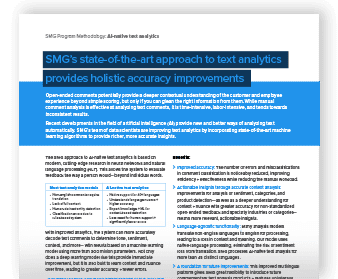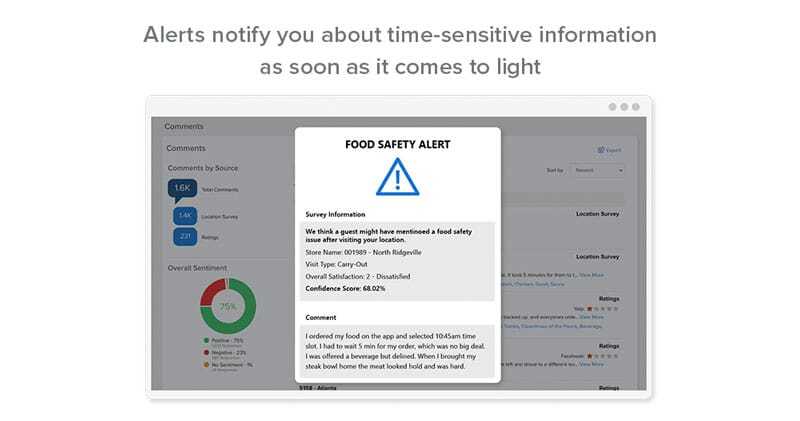Mitigate Operational Risk with Text Analytics and Customer Feedback
Published on Jun 15, 2022

You hate to see it happen, but every moment a critical issue remains unaddressed is a liability—whether it’s a serious customer service problem, a logistical issue, health risk, or a critical quality problem. Businesses need a way to find mention of these topics in their CX data quickly and effectively in the midst of the vast scale of data sources. An AI-powered text analytics customer feedback program mines customers’ unstructured input and alerts you to time-sensitive issues and potential oversights so you can take immediate action when the need arises.
Customer experience management is about using CX data to impact what happens next—and there’s no better way to do that than using a predictive analytic strategy including AI-native technology to provide deeper text analysis in real time.
Text analytics: The engine that drives insights
Modern user text feedback provides so much information, it has become no easy feat to manage with human hands alone. Since great CX feedback is essential for modern brands to reach their objectives in a competitive market, an effective text analytics customer feedback solution that assists with data processing is now a crucial part of that strategy.
Some of the most useful CX feedback comes from open-ended responses, which go beyond prescriptive customer surveys to give the customer the opportunity to tell you what’s on their mind. While it would be nearly impossible to have a person effectively and efficiently parse the huge influx of unstructured data collected this way, AI-native text analytics can lean on machine learning technology using artificial intelligence to sort the information and go straight to providing not just sentiment analysis, but also alerts that point to critical emergent issues. Text analytics streamlines analysis of open-ended customer experience feedback, an important part of surfacing what customers' perceptions are and where they come from. An efficient text analytics customer feedback solution is a reliable method for gleaning those insights you need to truly find the voice of the customer and take informed action on feedback data.

How AI-native text analytics drives improvements in CX sentiment accuracy
Language support for linguistic rules and statistical analysis
To only review individual words within unstructured text data is a textbook example of missing the forest for the trees. Applying natural language processing (NLP) is the best way to capture accurate customer sentiment within feedback—both at the whole-comment level and by phrase, product, or category. This type of sentiment analysis provides clients a breakdown with the best indication of what the customer really thinks and a path to surfacing specific customer needs.
To provide the best accuracy, these machine learning algorithms must support variables that inform sentiment, like the jargon of your industry or your particular geographic region. A great example of this is how words to express overall positive feedback in the U.S. like “neat,” “boss,” or “bomb” aren’t commonly used internationally.
Sentiment values can also benefit in different ways from adaptive learning, informing the accuracy of machine learning algorithms to continuously fine-tune sentiment accuracy to find customers' true opinions amid ever-evolving idioms and vernacular. For example: "This chicken is sick!" vs. "The chicken made me sick."
Domain-specific ontologies that allow for distinction between sub-industries
Unlike the quantitative data from surveys and other prescriptive customer feedback methods, findings from unstructured data are rarely constrained to just one area. More often, they’re spread across a wide array of products, services, channels, and initiatives—which means you need to have a centralized strategy to translate and analyze them.
This is where custom entity ontologies come in. Entity ontologies essentially serve as brand-specific encyclopedias—ensuring the lingo consumers use lines up with your own terminology. With customizable comment groupings, users can:
- Tag + group comments according to brand-specific product hierarchies
- Isolate categories + subcategories of interest for deeper analysis
- Refine areas of focus to keep customer satisfaction trending upward
Many text analytics customer feedback technologies either can’t handle the volume and complexity of the data being processed or they’re so convoluted it’s difficult to know where to start. More than ever, brands need robust, intuitive tools designed with a diverse range of team members' user experiences in mind—especially when it comes to input as nuanced as the unstructured data found in customer comments.
Learn about critical issues and areas of improvement faster
With so many feedback channels, it’s easy to see how that haystack of data can lead to major issues flying under the radar. SMG’s AI-native text analytics leverages industry-specific machine learning models—fed by billions of customer comments—to predict whether each piece of unstructured data indicates a “needle” issue that warrants your immediate attention.
Food safety detection is one very impactful example. There are few things that can damage a brand’s image more than foodborne illness. That’s why we made this our first priority and developed a model that detects when illness-related comments or phrases are referenced in unstructured feedback. Real-time alerts are a great way to bring to light these high-impact, low-frequency events—identifying potential food safety issues before they lead to widespread negative feedback, hit headlines, and become systemic issues.
The food safety model is trained to detect when a customer comments that they or someone they know got physically sick from food during a visit. It uses a proprietary algorithm that excludes tangential ideas—such as excessively short comments or fear of sickness—to reduce false positives and provide more accurate results.
Once a potential food safety incident is detected, SMG’s case management solution triggers a real-time alert so the brand can assess the incident and respond quickly.

This kind of streamlined process in a tech platform is the best way for companies to stay informed, respond quickly, and mitigate operational risk effectively. And as we’ve discussed in previous blogs, timing is everything when it comes to resolving customer issues—particularly those that involve their health. With 1 in 3 customers saying they’ll leave a brand they love after one bad experience, you need to act fast when trouble hits.
A key strategy for addressing issues and staying in-the-know
In a world where word travels fast, today's successful companies need to use all the tools they can to take action on critical issues quickly and effectively. Ensuring AI-native text analytics customer feedback is part of your customer experience program is a key way to mitigate operational risk by ensuring you have your finger on the pulse of what your customers are saying, however they may be saying it.
Related articles

Creating a Customer Experience App that Serves Customers First
As of last June, 81% of Americans owned a smartphone. In the throes of this convenience revolution—as more consumers turn to their phones for research and to make purchases—the pressure for brands to

How Brands Can Create Empathetic Customer Experiences In the New Normal
As of last June, 81% of Americans owned a smartphone. In the throes of this convenience revolution—as more consumers turn to their phones for research and to make purchases—the pressure for brands to

Bridge the Quantitative–Qualitative Gap in CX Feedback with Text Analytics
When it’s your job to listen to customers and act on their feedback, you absolutely have to be using text analytics. The world’s most successful brands know: it’s the surest way to glean rich insights